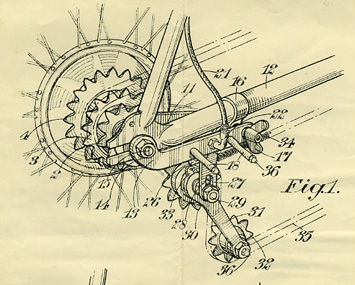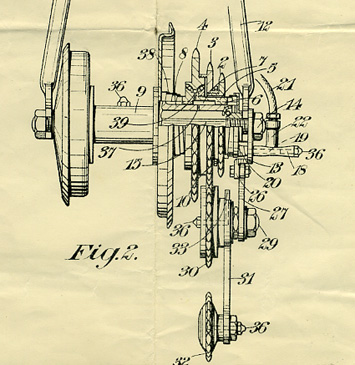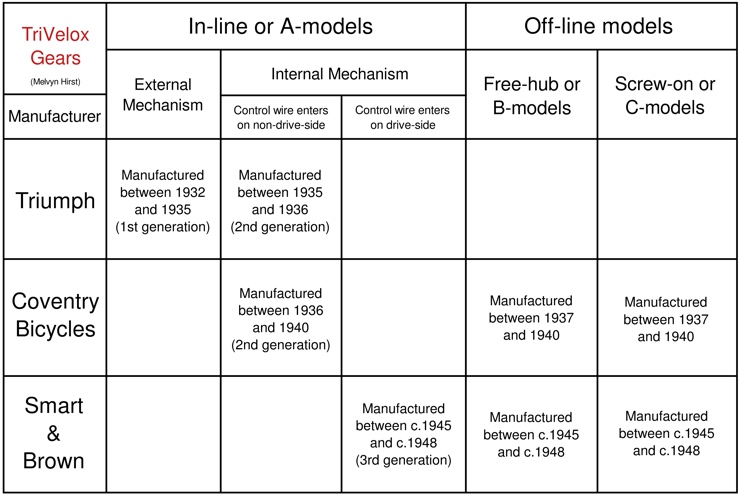Introduction
The three-speed cycle gear which became known as the TriVelox was patented by Alec Shuttleworth and William Hill in the early 1930s. It went into production in about 1932. Unlike other derailleur gears of the time and those of today, which move the chain to change gear, the TriVelox moved the sprockets instead. This ensured a perfect chain line for all three gears. In those days an in-line chain was regarded by some cycling authorities as an essential requirement and the lack of it was one of the reasons behind the contemporary antipathy towards derailleurs [1].
The complete patent document may be viewed here.
There is no evidence to suggest that either Shuttleworth or Hill were familiar with Edmund Hodgkinson's much earlier, but short-lived, Gradient gear: the Gradient also employed sliding sprockets but functioned by lifting the chain clear of them while changing gear [2]. It was exhibited at the 1899 Stanley Show in London [3]. However the patent agents for the TriVelox probably studied the patent for the Gradient and recognised the similarities between the two gears. Hence the patent application for the TriVelox emphasised its advantage over the Gradient, real or imagined, when it came to changing gear:
In a previous arrangement the chain has been lifted off one of the coaxially mounted sprockets and then dropped on the selected newly-aligned one after they had been shifted axially, a rather cumbersome operation during which free-wheeling was advisable. The main object of the [TriVelox] invention is to provide an improved arrangement which will be efficient and simple.
The TriVelox gear was developed at Tanfield Garage in Keighley. It was subsequently manufactured between 1932 and the late 1940s by three companies: first by the Triumph Company Limited in Coventry; second by TriVelox Gears Limited, a subsidiary of Coventry Bicycles Limited; and finally by the TriVelox Gear Company in Spennymoor, County Durham, a subsidiary of Smart & Brown (Engineers) Limited.
During the period of its manufacture the design of the gear was changed in two fundamental ways. First some major changes were made to the design of the gear as patented by Shuttleworth and Hill: the mechanism employed to move the sprockets from side to side and so keep the chain in-line was incorporated internally within the body of the hub. This revised model of gear, of which there were two versions or generations, became known as the A-model. The second fundamental change was the introduction of two variants of the traditional off-line or 'dancing chain' derailleur, the B and C-models. An overview of which models of the gear were manufactured by which company, and the periods during which they did so is shown below.
Images of the three versions or generations of the in-line or A-model, of which the Shuttleworth and Hill design was the first, can be viewed here.
Further details of all models, including the B and C-models, will be found on the company pages of the site. (To view a company page, click on a highlighted link such as the ones in the paragraph above, or on the link on the left-hand-side of any page.) The emphasis throughout, however, is on the in-line or A-model, which was clearly the most distinctive type of TriVelox gear. One way to begin exploring the site is to view the Tanfield Garage page.
Notes
1. For attitudes to derailleur gears at the time see, for example: Steve Griffith, 'The Der-Ri-Yur Change Gear Principle and British Attitudes', The Boneshaker, Winter 2015, pages 35-40. (The Boneshaker is the magazine of the Veteran-Cycle Club.) Footnote 10 of this article supports a production start date for the TriVelox of 1932.
2. For a history of the Gradient gear, see: Frank Berto. The Dancing Chain. 4th edition. San Francisco: Cycling Publishing, 2012, pages 54-55 and 57-58; and Ron Shepherd, 'The Origins of Derailleur Gears', The Boneshaker, Winter 1990, pages 5-10. Shepherd also describes, on pages 11-12, an in-line derailleur that was patented in 1909 by a Frenchman named Gabriel Hervier. This gear, a descendant of the Gradient, derailed the chain by merely pushing the cluster of sprockets from side to side with a metal finger and did not rely, as did the Gradient and most of its other descendants, on a device for lifting the chain. Hence the Hervier gear anticipated the TriVelox by more than twenty years, although unlike the TriVelox it required the use of two cables for its operation.
3. Information on the Stanley Show and its exhibitors may be found here.


